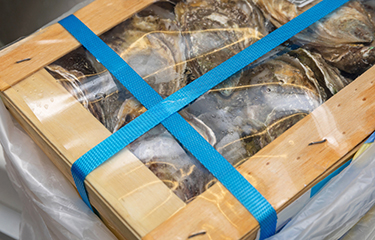A box of raw oysters in the United States is typically handled by two to seven companies while it moves through the supply chain – a long and circuitous path that, if not managed properly, can make the shellfish ripe for foodborne illnesses.
The middlemen in this process are crucial to keeping molluscs safe from contamination, and must ferry them from farm to consumer along temperature-controlled supply chains that are constantly refrigerated from harvest to plate. Gaps in the "cold chain" that lead to temperature spikes can lead to spoilage or growth of pathogens, whether during harvesting, processing, distribution, or even at the point of sale.
A new set of studies based on two years of research examined these cold chains and found that the majority of shipments were kept at temperatures low enough to meet the U.S. government’s food safety threshold. Some, however, did have temperatures that surpassed the recommended level, most often when shipping by air freight. Shorter, more direct supply chains were better at maintaining low temperatures.
The researchers at Johns Hopkins University, the Virginia Tech Seafood Agricultural Research and Extension Center, and the Pacific Shellfish Institute found that cold chains are generally well-maintained, but that the industry should develop best practices for shipping live oysters via airlines. Temperature sensors should also be used to verify that procedures and practices are working at the processor and distributor level.
Additionally, the researchers advised that the most critical time to prevent Vibrio bacteria — which causes vibriosis, a foodborne diseases connected to eating raw or undercooked shellfish — from growing is immediately after harvesting and during post-harvest processing. Layered ice slurries are more effective at controlling Vibrio growth than mechanical refrigeration alone.
“As our food supply becomes more global, proper handling and distribution of foods through every link in the supply chain is critical for protecting food safety and preventing waste,” Dave Love, associate scientist for the Seafood, Public Health and Food Systems Project at Johns Hopkins University's Center for a Livable Future, said in a statement.
The new research maps and tracks the performance of supply chains for farmed oysters in the U.S., relying on two years of research and visits to oyster farms in both the Chesapeake Bay region and Washington State. Most oyster farmers sell to wholesalers, who coordinate distribution with freight forwarders, and commercial trucking companies and airlines. Some shipments made it as far as Hong Kong.
Higher demand for oysters drove the researchers to study oyster supply chains and to better understand how to maintain food safety in different seasons, regions, and stages in the supply chain.
“Many people have heard the adage, ‘only eat oysters in months that end with the letter R.’ That’s in part because ‘R’ months are cooler and oysters can be preserved longer without spoiling. But today, there’s growing consumer demand for oysters year-round,” Love said.
Photo courtesy of Baloncici/Shutterstock







